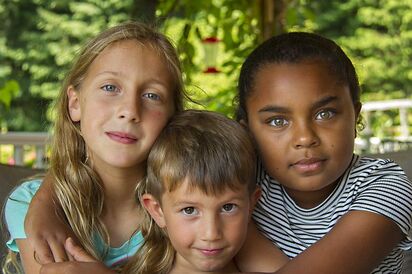Dr. Amy is a certified Sacro Occipital Technique (SOT) pediatric practitioner.
There is rapid growth in the human brain in the first two years of life; this period is when the greatest number and fastest development of neurological connections and pathways are created and formed. Because of this, this period is a critical period in which disruption of developmental processes, as the result of innate genetic abnormalities or as a consequence of environmental insults, may have long-lasting or permanent effects on brain structure and function and may lead to neurodevelopmental disorders. This time frame sets the baseline for future developmental potential on all levels. The fact suggests that there is a pressing clinical need to identify children at risk for developmental disorders within the first year of life and the initiate appropriate interventions.
Additionally, birth through age six is the most influential period of growth and development, as the brain records all sensory experiences as well as learning motor and sensory developmental skills--through environmental and social cues. Damage at any stage prior to the preliminary development of these functions (prior to age six) will cause compensatory patterns to either be learned or occur naturally to allow us to interact with our environment to the best of our ability.
Most developmental delays are not noticed until 3-4 yrs. old, but parents report that they noticed a change before 18 mos.
"The primary mechanism of injury to the spinal cord appears to be excessive traction applied to the spinal canal and cord during the birth process"-Symposium on operative obstetrics, Donn, MD: Vol.10, No. 2, June 1983
Birth trauma is also responsible for creating subluxations in the infant's spine. Assisted deliveries, including: C-sections, forceps, vacuum and induction procedures increase the chance of neurological damage to the infant's spine and nervous system. While many of these traumas go undetected at the time of occurrence diverse symptoms and conditions can occur later in life as a result of these uncorrected subluxation patterns.
By having your child checked (and adjusted) for spinal and cranial subuxations (misalignment causing interference in the nervous system), we can create the greatest functional threshold possible. If we can adjust any subluxations in this period of rapid developmental growth, the child's nervous system has the potential to be under less stress because the brain can better process anything that comes it's way.
When performing cranial/sacral work, we are changing the tension of the dural meningeal system and affecting the movement of cerebrospinal fluid (CSF). In turn, we can affect growth in cognitive and motor development patterns.
SOT concerns itself primarily with the cranial sacral respiratory mechanism. Although quite subtle, this motion is essential for the normal functioning of the brain and spinal cord, and thereby the rest of the nervous system and the rest of the body.
One common question we are asked is: Do SOT chiropractors do Craniosacral therapy?
In short, yes, those SOT doctors who continue their training are well versed in cranial manipulative therapies. We do craniosacral work based on a different protocol; what we do is more specific than a craniosacral therapist so by the time we work with the cranium, it works much faster than CST. However, a craniosacral therapist’s focus is generally on relaxing the person rather than actually making a clinical change in a specific type of clinical presentation. Craniosacral therapists are not doctors who are trained in diagnosing patients to discern when a patient may be having a serious condition needing specific care or a referral.
There is rapid growth in the human brain in the first two years of life; this period is when the greatest number and fastest development of neurological connections and pathways are created and formed. Because of this, this period is a critical period in which disruption of developmental processes, as the result of innate genetic abnormalities or as a consequence of environmental insults, may have long-lasting or permanent effects on brain structure and function and may lead to neurodevelopmental disorders. This time frame sets the baseline for future developmental potential on all levels. The fact suggests that there is a pressing clinical need to identify children at risk for developmental disorders within the first year of life and the initiate appropriate interventions.
Additionally, birth through age six is the most influential period of growth and development, as the brain records all sensory experiences as well as learning motor and sensory developmental skills--through environmental and social cues. Damage at any stage prior to the preliminary development of these functions (prior to age six) will cause compensatory patterns to either be learned or occur naturally to allow us to interact with our environment to the best of our ability.
Most developmental delays are not noticed until 3-4 yrs. old, but parents report that they noticed a change before 18 mos.
"The primary mechanism of injury to the spinal cord appears to be excessive traction applied to the spinal canal and cord during the birth process"-Symposium on operative obstetrics, Donn, MD: Vol.10, No. 2, June 1983
Birth trauma is also responsible for creating subluxations in the infant's spine. Assisted deliveries, including: C-sections, forceps, vacuum and induction procedures increase the chance of neurological damage to the infant's spine and nervous system. While many of these traumas go undetected at the time of occurrence diverse symptoms and conditions can occur later in life as a result of these uncorrected subluxation patterns.
By having your child checked (and adjusted) for spinal and cranial subuxations (misalignment causing interference in the nervous system), we can create the greatest functional threshold possible. If we can adjust any subluxations in this period of rapid developmental growth, the child's nervous system has the potential to be under less stress because the brain can better process anything that comes it's way.
When performing cranial/sacral work, we are changing the tension of the dural meningeal system and affecting the movement of cerebrospinal fluid (CSF). In turn, we can affect growth in cognitive and motor development patterns.
SOT concerns itself primarily with the cranial sacral respiratory mechanism. Although quite subtle, this motion is essential for the normal functioning of the brain and spinal cord, and thereby the rest of the nervous system and the rest of the body.
One common question we are asked is: Do SOT chiropractors do Craniosacral therapy?
In short, yes, those SOT doctors who continue their training are well versed in cranial manipulative therapies. We do craniosacral work based on a different protocol; what we do is more specific than a craniosacral therapist so by the time we work with the cranium, it works much faster than CST. However, a craniosacral therapist’s focus is generally on relaxing the person rather than actually making a clinical change in a specific type of clinical presentation. Craniosacral therapists are not doctors who are trained in diagnosing patients to discern when a patient may be having a serious condition needing specific care or a referral.
Proudly powered by Weebly


